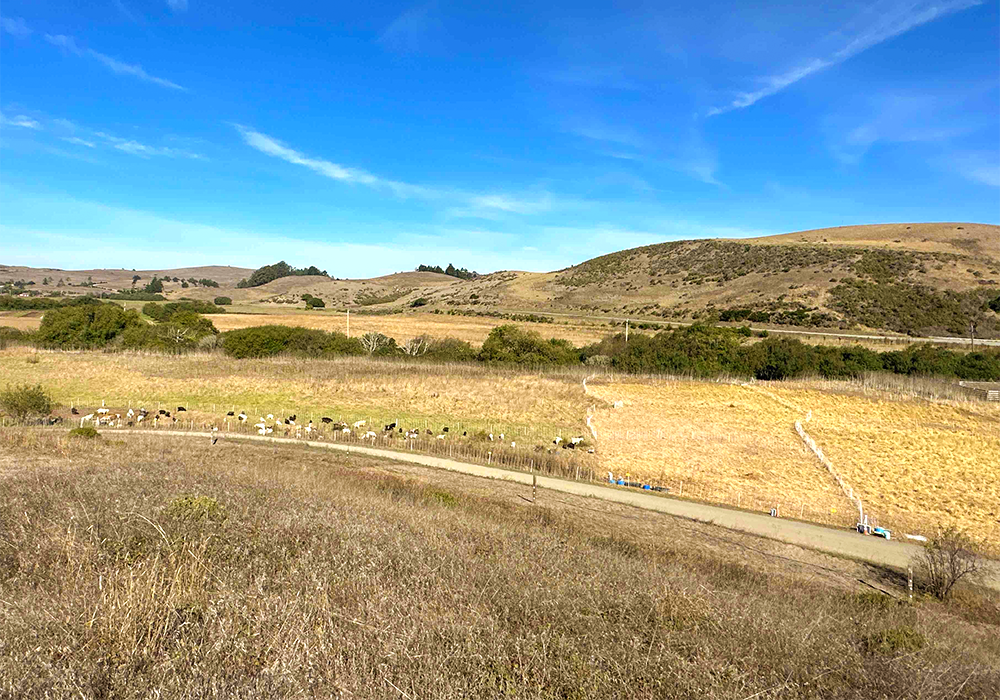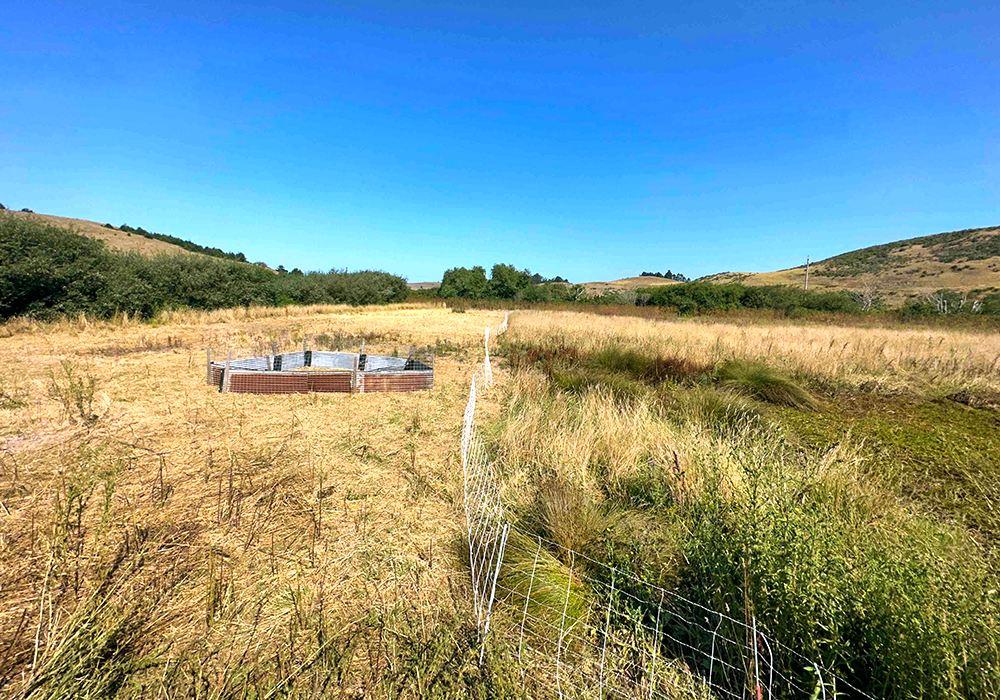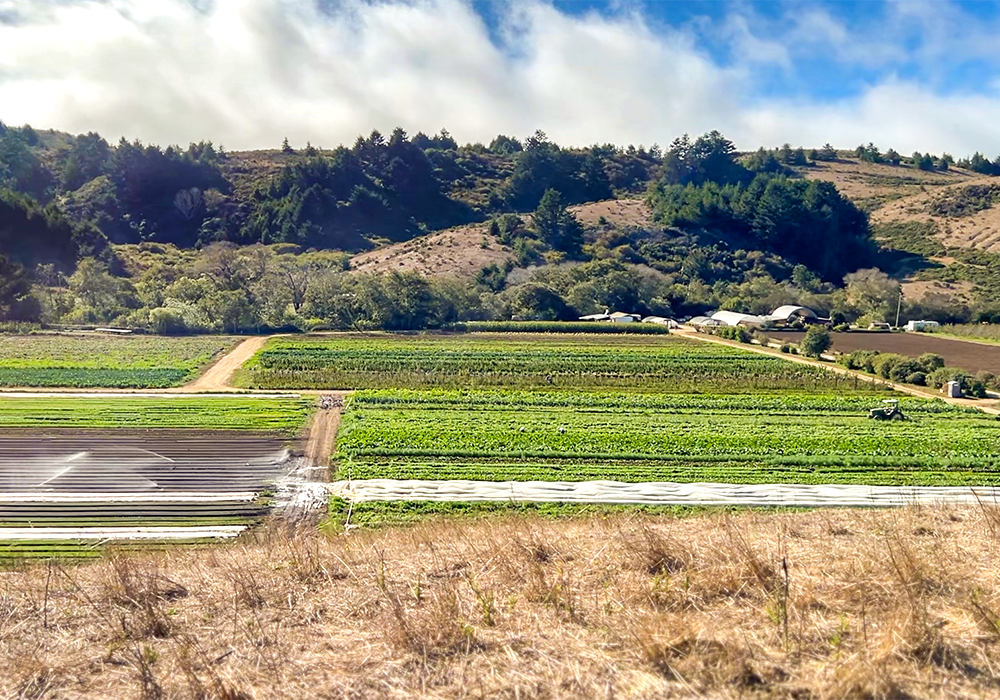California has seen many thousands of acres burn as catastrophic wildfires increase in size and intensity.
Grazing for Fire Mitigation at Fifth Crow Farm

TomKat Ranch Educational Foundation goats grazing at Fifth Crow Farm in Pescadero, CA.
11/27/2023
By: Mukethe Kawinzi
 California has seen many thousands of acres burn as catastrophic wildfires increase in size and intensity. Going hand in hand with drought, heat waves, other changing climatic conditions, and historical land management practices have contributed to the disastrous losses associated with these fires. As we face the threat of wildfires each year, we see the opportunity to employ a regenerative approach to fire mitigation that maintains healthy landscapes while promoting biodiversity, soil health, and water infiltration. To that end, TomKat Ranch Educational Foundation’s Small Ruminant Program has begun working in partnership with Fifth Crow Farm to use grazing to move toward a more fire-resilient landscape that better protects their crops, buildings, and people.
California has seen many thousands of acres burn as catastrophic wildfires increase in size and intensity. Going hand in hand with drought, heat waves, other changing climatic conditions, and historical land management practices have contributed to the disastrous losses associated with these fires. As we face the threat of wildfires each year, we see the opportunity to employ a regenerative approach to fire mitigation that maintains healthy landscapes while promoting biodiversity, soil health, and water infiltration. To that end, TomKat Ranch Educational Foundation’s Small Ruminant Program has begun working in partnership with Fifth Crow Farm to use grazing to move toward a more fire-resilient landscape that better protects their crops, buildings, and people.
TomKat Ranch is lucky to be nestled within a broader community of farmers and ranchers. Fifth Crow Farm is a diversified, certified organic farm located in Pescadero, California; their commitment to land stewardship shines through with the use of practices like compost spreading, the planting of native hedgerows, and cover cropping. As part of their dedication to sustainability, they invited our goat herd to graze their non-farmed fields this year as a means of lowering fire risk. For more information on the relationship between grazing and fire, check out these resources.

TomKat Ranch Educational Foundation brought our goat herd to Fifth Crow in August and began grazing on a knoll on the southern side of the farm property. This knoll was covered with dormant, headed-out annuals and Harding grass; sprawling patches of blackberry were spread among the grasses and an extensive stand of dry thistle made up one entire slope. Across a farm road from the knoll is a stretch of riparian field that, even late in the summer season, was lush with overgrown, verdant forbs like Water Parsley, Bristly Oxtongue, and various legumes. This divergent terrain was an opening to work creatively to meet our objectives of fuel reduction while giving our growing herd diverse, nutritious forage.
Goats are browsers: extraordinarily selective, they tend to sample forage across a landscape before deciding upon—and consuming—what they have determined to be the most palatable, nutritious choice. As graziers, we can modulate this impulse by varying paddock size, stocking density, and graze duration to guide impact depending upon the vegetation present. Strategically selecting bedding down areas, leveraging topography, and designing paddocks for forage diversity further directs the herd’s choices toward our goals. As the goats adapted to the overall novel feed at Fifth Crow, we incorporated multiple moves a day from the knoll to the riparian area, stimulating their appetite and minds, and prompting them to eat more. Using these methods to guide the herd broadens their impact, resulting in a more universal and even graze, removing more vegetation and, thus, fuel.
Maintaining high stock density, where appropriate, also helped us to break up lignified pasture that was otherwise unpalatable to the herd. While consumption is the primary method of reducing vegetation, trampling is additively effective in minimizing fuel loads. Placing the goats overnight in areas where feed was less desirable allowed for impact from trampling: the fine fuels that encourage fire speed and spread are broken up, worked into the soil, and diminished by the animals’ hooves.

Our herd of Spanish cashmere goats are a family unit; there are a variety of ages and sizes in the herd, giving us more flexibility in impact. When moved to a new area, different goats could be seen targeting different species: older wethers on their hind legs reached for the tops of browned hemlock, yearlings nosed through green flatsedge, and mother dams happily stripped clean long, meandering stems of invasive blackberry. Working together, the herd’s behavior combined to advance an even plane of reduced vegetation.
Fifth Crow has a beautiful expanse of willow trees along the fenceline that protects their crop fields. These trees overlook a dense understory of bramble, bushes, and thistle—all potential ladder fuels for the adjacent willows. Repeatedly herding the animals to this area and using our skills as shepherds to keep the goats focused on target species was another way to guide their impact while ensuring each individual herd member still had the ability to select for their personal forage needs and desires. At the same time, we allowed the herd to prune the trees for vigor without reaching the level of excess girdling that might harm them. Herding—as opposed to fencing—was a complementary way to vary the intensity, duration, and timing of grazing across the Fifth Crow property.
Increasing our collective resilience to climate change will require a variety of overlapping methods. Using grazing to reduce the risk, severity, size, and spread of wildfires can be a direct means of protecting our community. Our team found that we could simultaneously employ our goat herd for fire mitigation while meeting their nutritional and psychological needs and improving ecosystem function. With ruminants, we can reduce vertical and horizontal fuels while also creatively using herding and fencing to maintain native plant communities, wildlife habitat, and biodiversity. Risk of devastating wildfire remains ever-present; grazing lands intentionally and adaptively allows us a regenerative approach to fire mitigation and a local solution to mitigating the impacts of climate change.